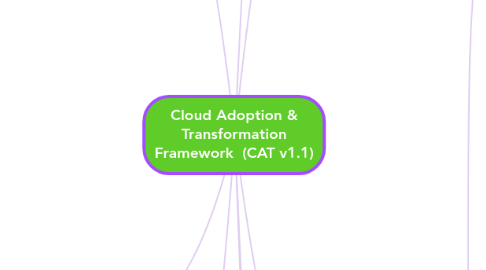
1. Goals & Objectives
1.1. Business
1.1.1. Increase Productivity & Accelerate Delivery
1.1.2. Improve ROI, Reduce TCO & Risk
1.1.3. Faster Time to Market
1.1.4. Improve Visibility & Enhance Predictability
1.1.5. Increase Business Agility
1.2. IT
1.2.1. Improve Business/IT Alignment
1.2.2. IT standards and architecture principles
1.2.3. Improve Software Quality, Reduce complexity
1.2.4. Enhanced Portfolio Governance
1.2.5. Manage Distributed Teams
1.2.6. Enhanced user experience
1.2.7. Reduce Operational Cost
2. Initiative & Strategy
2.1. Create Cloud Vision
2.1.1. IT services delivery Industrialization Model
2.1.2. On-demand Business Model
2.1.3. Model as a Fifth Utility
2.1.4. Innovation & Digital Economy
2.2. Identify Use Cases, Business & Innovation Driver
2.2.1. Platform Provisioning
2.2.1.1. Middleware
2.2.1.2. Application Run time
2.2.1.3. Infrastructure
2.2.2. Delivery Maturity
2.2.2.1. Six Sigma
2.2.2.2. Process Re-engineering
2.2.3. Process Standarization
2.2.3.1. Horizontal
2.2.3.2. Verticle
2.2.4. Business Intelligence
2.2.4.1. Predictive Analytics
2.2.4.2. Big Data
2.2.4.3. Mobile
2.2.4.4. Innovation Center
2.2.5. POC Capability
2.3. Define Business Outcomes and Projected ROI
2.3.1. Goals & Objectives
2.4. Identify Cloud Ecosystem
2.4.1. Enablers
2.5. Develop Metrics
2.6. Define Governance
2.6.1. Define Roles & Stakeholder Involvement
2.7. Define Roadmap
2.7.1. Execution Strategy
2.8. Define Solution
2.8.1. Patterns
3. Cloud Enablers
3.1. Cloud Deployment Model
3.1.1. Private Cloud
3.1.2. Public Cloud
3.1.3. Hybrid Cloud
3.1.4. Community Cloud
3.2. Cloud Service Type
3.2.1. BPaaS
3.2.1.1. Procurement
3.2.1.2. Employee Benefit Mgmt.
3.2.1.3. ...
3.2.2. SaaS
3.2.2.1. Financial
3.2.2.2. CRM
3.2.2.3. ERP
3.2.2.4. ...
3.2.3. PaaS
3.2.3.1. Middleware
3.2.3.2. Application Runtime
3.2.3.3. Development Tools
3.2.4. IaaS
3.2.4.1. Servers
3.2.4.2. Storage
3.2.4.3. Networking
3.3. Strategic Tools & Platforms
3.3.1. API Gateway & Management
3.3.1.1. IPaaS vs SaaS model
3.3.1.2. APIGEE
3.3.1.3. Layer7
3.3.1.4. Akana
3.3.2. API Governance
3.3.2.1. Akana
3.3.3. Middleware
3.3.3.1. Mulesoft
3.3.3.2. Akana
3.3.4. Cloud Host Services
3.3.4.1. MS Azure
3.3.4.2. AWS
3.3.4.3. IBM Bluemix
3.3.5. Event Management
3.3.5.1. AWS EC2
4. CAT Assessment Model
4.1. IT Maturity Assessment Model
4.1.1. Initial
4.1.1.1. Startup, None or few Standard Process, Adhoc
4.1.2. Managed
4.1.2.1. Reactive, Project Oriented
4.1.3. Defined
4.1.3.1. Proactive
4.1.4. Defined Managed
4.1.4.1. Measured & Controlled
4.1.5. Optimizing
4.1.5.1. Focus on Process Improvement
4.1.6. Transition
4.1.6.1. Growth, Merge or Acquired, Disruptive Innovation
4.2. Client Ecosystem Compatibility assessment Model
4.3. Deployment Type Assessment Model
4.4. Custom vs. COTS Model
4.5. COTS Product Assessment Model
4.5.1. Azure
4.5.2. AWS
4.6. Domain Specific Assessment Model
4.6.1. Healthcare
4.6.2. Retail
4.6.3. ...
4.7. Domain Specific Industry Trends
4.8. Cloud Consumption Model
4.8.1. Pricing Comparison
4.8.2. Cloud Sizing
4.8.3. Network
4.9. ROI Assessment Model
4.10. Sizing & Effort Estimations model
5. CAT Matrics
5.1. Use case Matrics
5.1.1. Generic
5.1.2. Domain Specific
5.2. Business & IT Alignment Matrics
5.3. Integration Patterns Matrics
5.4. Product assessment criteria matrics
5.5. Domain Specific Industry tool trend matrics
5.6. Cloud Services, Deployment type and COTS matrics
5.7. Key Industry Challenges and Risk matrics
5.8. RACI matrics
6. CAT Solutions
6.1. Reference Architecture
6.1.1. Based on Cloud Vision
6.1.2. Private Cloud
6.1.3. Hybrid Cloud
6.1.4. Public Cloud
6.1.5. Community Cloud
6.2. Solution Architecture
6.2.1. Deployment Model Specific
6.2.2. Service Type Specific
6.2.3. IT Maturity Specific
6.2.4. Domain Specific Solution
6.2.4.1. Domain Specific Process Model
6.2.4.2. Healthcare
6.2.4.2.1. Key Processes
6.2.4.2.2. Key Patterns
6.2.4.2.3. Key Tools
6.2.4.3. Retail
6.2.4.4. ...
6.2.5. Architecture Patterns
6.2.5.1. Layered
6.2.5.2. Event Driven
6.2.5.2.1. Mediator Topology
6.2.5.2.2. Broker Topology
6.2.5.3. Microkernel
6.2.5.4. Microservice
6.2.5.4.1. API rest-based
6.2.5.4.2. Application rest-based
6.2.5.4.3. Centralized Messaging
6.2.5.4.4. Distributed Messaging
6.2.5.4.5. Embedded Messaging
6.2.6. Cloud Data Cache
6.2.7. Enterprise Solutions
6.2.7.1. Identity Management
6.2.7.2. API Gateway (Internal vs. External)
6.2.7.3. Mobile (?)
6.2.8. Standards & Best Practice
6.2.8.1. Canonical Model
6.2.8.2. Rest vs SOAP
6.2.8.3. Integration Framework
6.2.8.3.1. Docker/Spring
6.2.8.4. Service Granularity
6.2.8.5. Service Versioning
6.2.8.6. Reuse vs New Service
6.2.8.7. Private vs Public Service
6.2.8.7.1. Standards & Best Practice
6.3. Patterns
6.3.1. Application Integration Patterns
6.3.2. Data Integration Patterns
6.4. Security Model
6.4.1. API
6.4.2. Service
6.4.3. Authentication/Authorization
6.4.4. Design Principles
6.5. Business Rule Engine
6.6. Case Study
7. CAT Governance
7.1. Run time Governance Strategy
7.1.1. Process
7.2. Design time Governance Strategy
7.2.1. People
7.2.1.1. RACI
7.2.2. Tool
7.3. Roles
8. CAT Execution Strategy
8.1. Service Catalog / Taxonomy Template
8.1.1. Domain Specific
